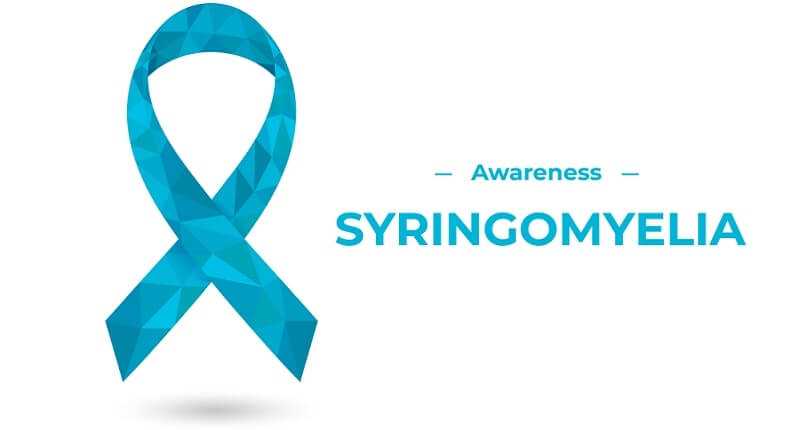About Syringomyelia

AKA syrinx. Cystic cavitation of the spinal cord. Rostral extension into brainstem is termed syringobulbia. Syrinx may be divided into specific subtypes (based on etiology, cell-type of lining, or presence/absence of communication with the central canal); terms include hydrosyringomyelia.
May be associated with certain congenital or neoplastic conditions, or may follow significant spinal trauma (with or without clinical spinal cord injury). Two main forms:
- communicating syringomyelia: primary dilatation of the central canal. Almost always associated with abnormalities of the foramen magnum, e.g. Chiari type 1 malformation (the most common form) or basilar arachnoiditis (post-infectious or idiopathic). Simple central canal dilatation with ependymal cell lining is called hydromyelia, extension into the cord parenchyma constitutes true syringomyelia
- noncommunicating syringomyelia: cyst arises in cord substance and does not communicate with central canal or subarachnoid space. May be due to trauma, neoplasm (mostly gliomas), or arachnoiditis. True syrinx cavities contain fluid of the same constituency as CSF, whereas tumor cyst fluid is usually highly proteinaceous
Communicating syringomyelia
Pathophysiology
Etiology probably lies in outlet obstruction (partial or complete) of fourth ventricle (foramina of Luschka and Magendie). Congenital conditions such as Chiari malformation (type 1 or 2), cerebellar ectopia, basilar impression (with constriction of the foramina), Dandy-Walker syndrome, and acquired conditions such as adhesive arachnoiditis are associated with high incidence of syrinx.
- Major theories of formation of the cyst:
hydrodynamic (“water-hammer”) theory of Gardner: systolic pulsations are transmitted with each heartbeat from the intracranial cavity to the central canal. Has been essentially disproven using MRI - Williams’ theory: maneuvers that raise CSF pressure (valsalva, coughing…) cause “hydrodissection” through the spinal cord tissue. May be more common in noncommunicating syringomyelia
Clinical
Highly variable presentation. Most progress slowly over years.
Characteristic syndrome
(nonspecific for intramedullary spinal cord pathology):
- sensory loss (similar to central cord syndrome) with a suspended (“cape”) dissociated sensory loss
(loss of pain and temperature sensation with preserved touch and joint position sense -> painless
ulcerations from unperceived injuries) - cervical and occipital pain
- lower motor neuron hand and arm weakness
- painless (neurogenic) arthropathies (Charcot’s joints): seen in < 5%
Evaluation
Prior to the CT/MRI era, diagnosis relied on myelography or on autopsy.
MRI : defines anatomy in sagittal as well as axial plane. Test of choice.
CT : low attenuation area within cord seen on either plain CT or myelogram/CT (with water soluble contrast).
Myelogram : rarely used alone (usually performed in conjunction with CT). When used alone: often normal (false negative), some -> complete block at level of syrinx; iodine contrast studies may show fusiform widening of spinal cord, whereas air contrast studies may show collapse of the cord .Dye may slowly leach into the cyst.
Management
Surgical treatment
Options include:
- posterior decompression: procedure of choice when posterior anomalies (e.g. Chiari malformation) are present
- shunts: K or T tube drainage; choice of distal sites includes: A. peritoneum (difficult in cervical region) B. subarachnoid space (e.g. Heyer-Schulte-Pudenz system): requires normal CSF flow in subarachnoid space, therefore cannot use in arachnoiditis
- plugging the obex with muscle, teflon, or other substance is recommended
- syringostomy: usually fails to remain patent, therefore using a stint or a shunt (syringosubarachnoid or syringoperitoneal) is recommended
- percutaneous aspiration of the cyst (may be used repeatedly)
Technical considerations:
1. intraoperative ultrasound is often helpful for:
A. localizing the cyst
B. assessing for septations (to avoid shunting only part of cyst)
2. if Chiari malformation is not present, consider syringosubarachnoid shunt as the initial procedure. If this fails, then syringoperitoneal shunt may be inserted
3. Rhoton suggests performing the myelotomy in the dorsal root entry zone (DREZ), between the lateral and posterior columns (instead of the midline as with a tumor) because this is consistently the thinnest part and there is usually already an upper extremity proprioceptive deficit from the syrinx. There is = 10% incidence of posterior column dysfunction with shunting
4. with syringosubarachnoid shunts, be sure the distal shunt tip is subarachnoid (and not just subdural) or else it will not function
5. with syringopleural shunt, the pleural opening can be made posteriorly , adjacent to one of the ribs as described for ventriculopleural shunt
Posttraumatic syringomyelia
A form of noncommunicating syringomyelia. This discussion deals with cases of posttraumatic syringomyelia (PTSx) following penetrating injury or non-penetrating “violent” trauma to the spinal cord (injuries such as post-spinal anesthesia or following thoracic disc herniation are not included).
Pathophysiology
Etiology appears different than that of “spontaneous” syrinx. Proposed theories are vague, and include:
1. “slosh” theory: pulsatile pressure surges of fluid in the cord following injury
2. “suck” theory: upward peaks of negative pressure (e.g. during period following Valsalva maneuver) working via a ball-valve effect
3. coalescence of microcysts
Epidemiology
Often a late presentation following spinal cord injury, therefore incidence is higher in series with longer follow-up. Incidence increasing with increasing survival following spinal cord injury and as MRI becoming more available. Range: ~ 0.3-3% of cord injured patients (see Table 1).
Table 1
Incidence of posttraumatic syringomyelia
| Type of injury | No/risk* | Incidence |
| all spinal cord injury patients | 30/951 | 3.2% |
| complete quadriplegics | 14/177 | 7.9% |
| incomplete quadriplegics | 4/181 | 4.5% |
| complete paraplegics | 4/282 | 1.7% |
| incomplete paraplegics | 4/181 | 2.2% |
* number occurring over number at risk in 951 patients followed for 11 years
In a large number of patients followed via multicenter cooperative data bank, there were fewer cases of syrinx following cervical injuries than following thoracic injuries (may be artifactual since patients with lower lesions may be more aware of ascending levels).
Latency following spinal cord injury:
- latency to symptoms: 3 mos to 34 yrs (mean 9 yrs) (earlier in complete cord lesions than incomplete: mean 7.5 vs. 9.9 yrs)
- latency to diagnosis: up to 12 yrs (mean 2.8 yrs) after onset of new symptoms
Clinical
The presentation of patients with PTS x is shown in Table 2. The late appearance of upper extremity symptoms in a paraplegic patient should raise a high index of suspicion of posttraumatic syringomyelia.
Hyperhidrosis may be the only feature of descending syringomyelia in patients with complete cord lesions.
Evaluation
See Communicating syringomyelia. One end of the cavity is often found at a site of spinal column fracture or abnormal angulation.
Management
Many authors advocate early surgical drainage of cyst as a means of reducing increased delayed deficit. Some authors feel that aside from disturbing sensory symptoms, that motor loss was infrequent and therefore conservative management is indicated in most cases.
Table 2
Presentation(in 30 patients with Syrinx)
| Symptom | Initial | At time of diagnosis | |
| pain* | 57% | 70% | |
| numbness | 27% | 40% | |
| increased motor deficit | 23% | 40% | |
| increased spasticity | 10% | 23% | |
| increased sweating (hyper- hidrosis) | 3% | 13% | |
| autonomic dysreflexia | 3% | 3% | |
| no symptoms | 7% | 7% | |
| Signs | Frequency | ||
| ascending sensory level | 93% | ||
| depressed tendon reflexes | 77% | ||
| increased motor deficits | 40% | ||
* pain is often quite severe, and unrelieved with analgesics
Medical
Managed non-surgically: 31% stable, 68% progressed over yrs (longer F/U in latter).
Surgical
There is probably no benefit in operating on a patient with a small syrinx.
Surgical options: As in Communicating syringomyelia, with the following differences:
• cord transection (cordectomy): an option in complete injuries only
• unlike congenital syrinx, plugging the obex is felt not to be indicated

